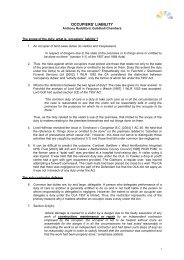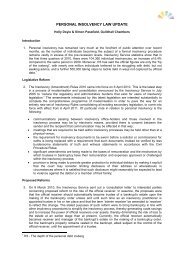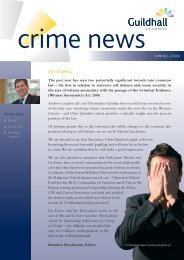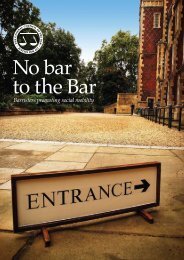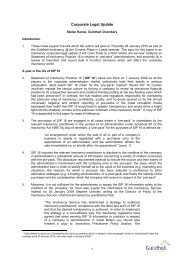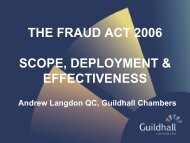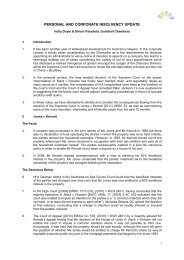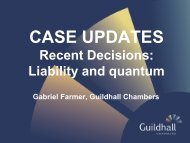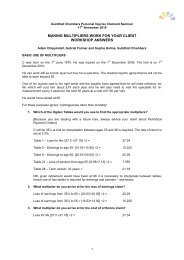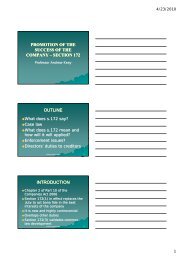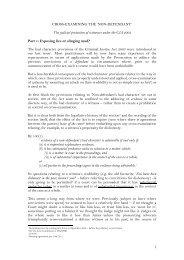Personal and Corporate Update - Holly Doyle & Simon Passfield
Personal and Corporate Update - Holly Doyle & Simon Passfield
Personal and Corporate Update - Holly Doyle & Simon Passfield
You also want an ePaper? Increase the reach of your titles
YUMPU automatically turns print PDFs into web optimized ePapers that Google loves.
present right to compel the trustees of his pension to make payments under the policy in thefuture;(2) Section 310 IA 1986 (as it then stood) does not apply to property or income which alreadyvests in the trustee pursuant to section 306 IA 1986;(3) Therefore the right to payment of the annuity payable under the policy vested in the trustee onhis appointment <strong>and</strong> section 310 IA 1986 had no application to it when it became payable.Further, after the right to receive the annuity under the policy vested in the trustee he was theonly person entitled to exercise the options conferred by the policy on the annuitant <strong>and</strong> couldtherefore exercise the option to commute part of the annuity into a lump sum.37. Following this decision it became the practice of trustees to lay claim to a bankrupt’s right in hispension <strong>and</strong> to exercise the rights of the bankrupt under the policy as they saw fit.38. The decision prompted a legislative response in Section 11 of the Welfare Reform <strong>and</strong> PensionsAct 1999, which provides that (where a bankruptcy order is made against a person on a petitionpresented after the coming into force of the section) the bankrupt’s rights under an approvedpension arrangement are excluded from his estate. The “bundle of contractual rights” <strong>and</strong>benefits of the bankrupt’s pension policy therefore no longer vests in a trustee upon hisappointment but remains vested in the bankrupt.39. At the same time the partial definition of the bankrupt’s “income” in section 310(7) of the IA 1986(dealing with IPOs) was amended to include:“ every payment in the nature of income which is from time to time made to him or to which hefrom time to time becomes entitled, including…(despite anything in s 11 or 12 of the welfareReform <strong>and</strong> Pensions Act 1999) any payment under a pension scheme…” .40. It appears clear therefore that where a bankrupt has given notice to the pension fund of hiselection to take up his rights under the pension scheme, any lump sum or periodic payment hereceives remains his property save to the extent that the trustee has obtained an IPO pursuant tosection 310 IA 1986. Further, the right to elect when <strong>and</strong> how to draw his pension remains vestedin the bankrupt.41. However, the Chancery Division has recently considered the question of whether a debtor whohad not yet elected to draw his pension could nevertheless be compelled to elect to do so for thebenefit of his creditors in two decisions: Blight, Meredith <strong>and</strong> Lewis v Brewster [2012] EWHC 165(Ch) (outside the insolvency regime) <strong>and</strong> Raithatha v Williamson [2012] EWHC 909 (Ch) (withinthe insolvency regime).42. In Blight, Meredith <strong>and</strong> Lewis v Brewster [2012] EWHC 165 (Ch) the Court was called on toconsider the question whether a judgment creditor (C) could execute against the judgment’sdebtor (D)’s right to draw down 25% of his pension as a tax free sum.43. At first instance the District Judge had held that:(1) C could not apply for a third party debt order unless D had made the election to drawdown the lump sum, because until that point there was no debt, <strong>and</strong>(2) there was no jurisdiction in the Court to force D to make an election to take his lump sumwhich was not in his financial interest.44. On C’s appeal, Gabriel Moss QC reversed the decision in the court below, ordering D to delegateto C’s solicitor the power to make the election to draw the lump sum payment up to the amountneeded to repay the balance of the judgment debt in D’s name <strong>and</strong> restoring the third party debtorder discharged below, to take effect from the moment that the debt created by the election totake the lump sum became effective.45. The Judge started his reasoning from his impression that the contrary result would work asubstantial injustice to C, <strong>and</strong> that the idea that D (a fraudster <strong>and</strong> forgerer) could enjoy anenhanced st<strong>and</strong>ard of living at his retirement instead of paying a judgment debt, where he had




